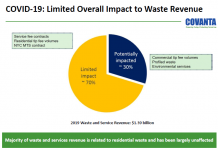by Jim Lane
What a whirlwind weekend after the U.S. Environmental Protection Agency announced their final renewable volume obligations (RVO) under the Renewable Fuel Standard program for 2019. “It’s just numbers,” some say, but oh no, not in the biofuels world. It’s never just numbers. This time it’s about waivers, fixing the damage done, and ensuring a bright future for biofuels. It’s about hollow chocolate bunnies and two steps back for some.
French mathematician Rene Descartes is best known for “I think, therefore I am,” but he also said “Perfect numbers, like perfect men, are rare.” So true in this case as not everyone is happy about EPA’s numbers and how they relate to small refiner waivers. If you want to know get the details on the digits from EPA, the waiver what-what, the reactions ‘round the country from biodiesel, biogas, ethanol and more, the Digest has you covered.
The Numbers
If you just look at the numbers alone, they look pretty decent for biofuels compared to 2018 numbers. Unlike the stock market, nothing went down and most went up, albeit slightly. They include a total renewable fuel volume of 19.92 billion gallons (up from 19.28 which is about 3% increase), of which 4.92 billion gallons (up from 4.29) is advanced biofuel, including 418 million gallons (up from 288) of cellulosic biofuel, 2.1 billion gallons of biomass-based diesel (same as 2018). That leaves a 15-billion-gallon requirement for conventional renewable fuels like corn ethanol. You can read the EPA’s Final Rule here.
The Reactions – from chocolate bunnies to two steps back
“Without reallocation of small-refinery exemptions, the numbers released today may look good on the outside, but just like the chocolate bunnies my children open up on Easter morning, they are hollow on the inside,” said Iowa Renewable Fuels Association Executive Director Monte Shaw. “While any increase is better than a flatline, these modest increases vastly underrate the potential of advanced biofuels.”
Iowa Corn Growers Association’s President Curt Mether said that while happy to see the EPA’s numbers for corn-based ethanol, they have a very important request for the EPA: “stop granting unnecessary waivers to obligated parties and not to include those waivers in its formula for determining annual volumes as required under the RFS. This intentional omission effectively cuts ethanol demand and works against the goals of the RFS program to the detriment of motorists, our environment, and Iowa’s corn farmers.”
Growth Energy CEO Emily Skor, said that while the numbers are a positive step forward and they “hold promise with a 15-billion-gallon commitment to starch ethanol and 418 million gallons of cellulosic biofuels,” the billions of lost gallons due to excessive small refinery exemptions need to be accounted for. “Until these are addressed properly, we’re still taking two steps back for every step forward,” said Skor.
South Dakota-based American Coalition for Ethanol CEO Brian Jennings agrees the exemptions are a huge issue and is “fighting this injustice with a challenge of three specific Small Refinery Exemptions (SREs) in the U.S. Court of Appeals for the 10th Circuit and a petition asking EPA to account for the lost volumes resulting from retroactive SREs.”
U.S. Sen. Chuck Grassley of Iowa said that the 2019 numbers are good news and encouraging but the true test is yet to come. Senator Grassley met with EPA’s Acting Administrator Wheeler and said he is “optimistic about the potential for a revisiting of this practice” referring to the hardship waivers to multibillion-dollar oil companies. “There’s no good reason oil companies making billions of dollars in profits should be exempted from following the law as passed and intended by Congress. I’m disappointed the rule didn’t reallocate waived volumes to make up for the damage done by former Administrator Pruitt.”
Grassley remains hopeful and said, “Specifically, I’m glad levels for biodiesel are maintained and slightly increased. And although the levels for advanced biofuels and cellulosic biofuels don’t represent the full potential of the industry, they are very promising and will help significantly.”
Renewable Fuels Association President and CEO Geoff Cooper didn’t mince words when he said that the “EPA did not prospectively account for any small refiner exemptions that it expects to issue in 2019. Hopefully, that means EPA is not intending to issue any small refiner waivers at all in 2019 because it knows there is no rationale or basis for doing so.”
National Corn Growers Association (NCGA), Lynn Chrisp, Nebraska farmer and president said they are happy about the numbers for conventional ethanol but upset about the waivers and said, “When the EPA continues to grant waivers and does not account for those volumes in this rule, domestic demand for our crop is lost, impacting farmers’ livelihood and the economy of rural America.”
POET’s Kyle Gilley, Senior Vice President of External Affairs and Communications also addressed the waivers and said, “It is time to get our America First fuel policy back on track, and we encourage the acting EPA administrator to hold oil refiners accountable and maintain the integrity of the Renewable Fuel Standard.”
Biotechnology Innovation Organization’s Brent Erickson, executive vice president of BIO’s Industrial & Environmental Section applauded the EPA for “increasing advanced and cellulosic biofuel volumes from 2018,” but expressed disappointment that “EPA missed this opportunity to reallocate gallons displaced from small refinery waivers, issued at the behest of the petroleum industry.” He said that the “EPA also needs to approve new biofuel pathways and facility registrations to allow volumes of advanced and cellulosic biofuels to grow.”
Advanced Biofuels Business Council’s Executive Director, Brooke Coleman, said, “The final targets open new possibilities for advanced and cellulosic biofuels, but without a check on abusive EPA waivers, we’ll continue to see plants closing their doors or idling production. The agency cannot fulfill the president’s commitments in the heartland without putting a lid on handouts to oil giants like Chevron and Andeavor.”
In a joint statement, Americans for Energy Security and Innovation Co-Chairs Jim Talent and Rick Santorum said that the new targets represent a “modest step forward for U.S. energy security, but that promise will be short-lived unless the EPA puts a lid on abusive waiver practices. Dozens of handouts to well-connected refiners have already destroyed demand for more than two billion gallons of American-made biofuel.”
The American Biogas Council was pretty happy about the EPA numbers and for good reason since “Of the 418 million gallons of cellulosic biofuel called for in the RFS, the vast majority, 388 million gallons, are requested from biogas and that represents a 45% increase in production from the 2018 volumes,” said Patrick Serfass, the ABC Executive Director. “This is a concrete validation of the significant growth in the biogas industry year over year. At the same time, we are disappointed, again, that this rule shows zero progress toward activating the biogas to renewable electricity (eRIN) pathway. We want EPA to activate the eRIN pathway immediately by processing the project registrations that are already in EPA’s hands.”
Johannes Escudero, CEO of the Coalition for Renewable Natural Gas, was appreciative of the 2019 numbers and said it “reflects continued growth in the renewable natural gas industry.” The RNG industry produces 95% of the fuel used to meet the RFS program’s cellulosic biofuel requirement, according to RNG Coalition. “The growth in production of renewable natural gas and the completion of nearly 50 new production facilities from coast to coast since 2014 is proof positive that the RFS is working as intended for cellulosic and advanced biofuels,” said Escudero. But even Escudero hopes the EPA will ensure that small refiner exemptions “are administered in a way that do not undermine the program’s advanced biofuel requirements.”
The National Biodiesel Board (NBB) said, “EPA’s failure to properly account for small refinery exemptions will continue to destroy biodiesel demand.” Yes, destroy. In other words, it’s just not enough. NBB CEO Donnell Rehagen said, “EPA recognizes that the biodiesel and renewable diesel industry is producing fuel well above the annual volumes. The industry regularly fills 90 percent of the annual advanced biofuel requirement. Nevertheless, the agency continues to use its maximum waiver authority to set advanced biofuel requirements below attainable levels. The method is inconsistent with the RFS program’s purpose, which is to drive growth in production and use of advanced biofuels such as biodiesel.”
Iowa Biodiesel Board said that farmers are disappointed by the RFS rule and the modest changes made. Grant Kimberley, their executive director pointed out that the “small refinery exemptions reduced demand for biodiesel by more than 300 million gallons in 2018 – the equivalent of the entire state of Iowa’s biodiesel production.”
There are others not happy about the new numbers too, but in a different way, like the National Council of Chain Restaurants which has repeatedly asked Congress to repeal the RFS and on Friday called on the EPA to completely review biofuel levels under the federal RFS, saying increased levels announced for 2019 meet requirements for a “reset” of the program. NCCR Executive Director David French said, “Not only are those old levels wildly unrealistic for advanced fuels, the levels required for last-generation, conventional corn ethanol are unnecessary and run counter to the law’s environmental goals. Corn ethanol is flatly bad for the environment and consumers alike, and it’s high time for the mandate to go away.”
Bottom Line
So what does EPA need to do to really help the biofuel economy? They need to look at the waivers. They need to reverse the damage done from the previous waivers and not turn a blind eye to what the industry is telling them. As NBB points out, “In the final rule, EPA states that it has not received small refinery exemption petitions for 2019 and therefore estimates zero gallons of exempted fuel in its RVO formula.”
But is that realistic? The EPA has estimated “zero gallons every year since 2015, even though it retroactively exempted more than 24.5 billion gallons of fuel between 2015 and 2017, according to NBB. RFA’s Cooper brings up the fact that “Pruitt issued nearly 50 refinery waivers from 2016 and 2017 RFS requirements, including bailouts to companies like Chevron (CVX) and Andeavor (ANDX) that recorded billions of dollars in net profits in those years.”
NCCR also brings up a good point that the new numbers “are high enough to set in motion a reset of the RFS program required by law when levels deviate more than 20 percent from those allowed under the RFS statute for two consecutive years. The reset means the EPA is required to conduct a complete review biofuel levels under the program, which could lead to lower levels being set.”
While the reactions are mixed, they mostly have one thing in common – the EPA needs to deal with the small refiner waivers, so we will see if the EPA is listening.
Jim Lane is editor and publisher of Biofuels Digest where this article was originally published. Biofuels Digest is the most widely read Biofuels daily read by 14,000+ organizations. Subscribe here.








